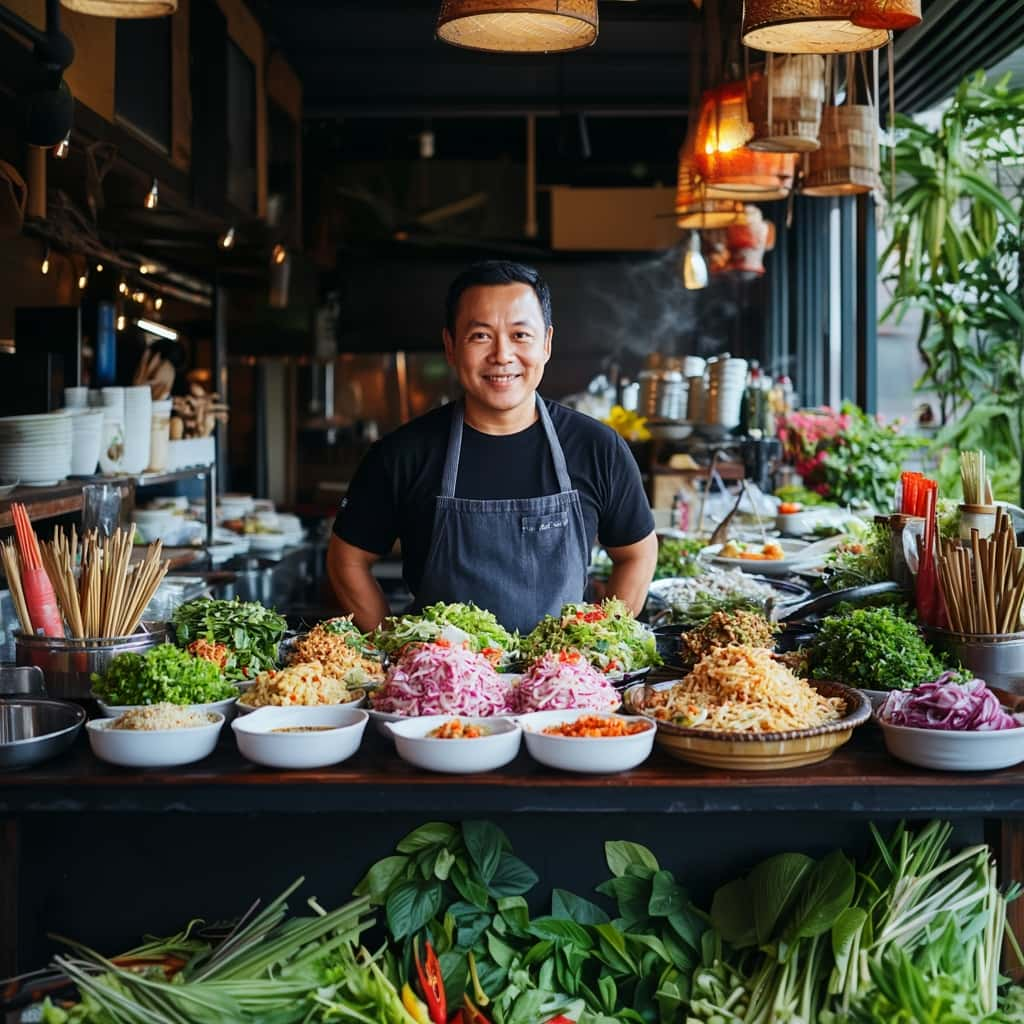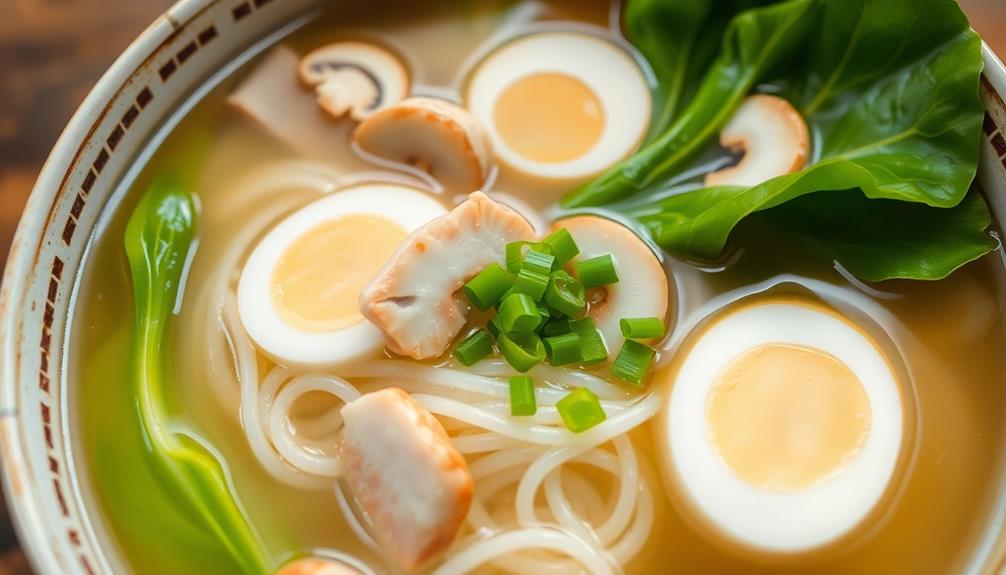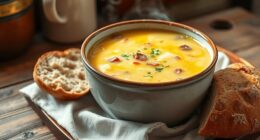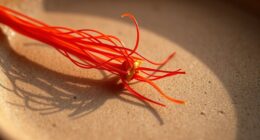Khao Pad, the beloved Thai fried rice dish, showcases the harmonious flavors of Thai cuisine, seamlessly blending savory, sweet, and tangy elements through a well-executed stir-frying technique that's been perfected over generations. This versatile dish starts with chilled rice, eggs, protein, and veggies, coming together in a symphony of textures and tastes. Master the art of Khao Pad, and you'll unlock a satisfying go-to meal that can cater to your personal preferences. Want to dive deeper into the history and cultural significance of this classic Thai dish? Let's explore further.
Key Takeaways
- Khao Pad is a beloved Thai staple dish with a harmonious balance of savory, sweet, and tangy flavors, influenced by Chinese, Malay, and Indian cuisines.
- The dish showcases the versatility of Thai cooking, allowing for customization based on preferences and ingredient availability.
- Proper stir-frying technique is essential to achieve the perfect Khao Pad, with the use of day-old rice and precise timing of ingredients.
- Khao Pad is a satisfying go-to meal that demonstrates developed culinary skills and encourages confidence in cooking abilities.
- The dish's adaptability caters to diverse dietary needs and tastes, encouraging creativity in meal preparation.
History
Khao Pad, Thailand's iconic fried rice dish, has a rich and storied history that can be traced back to the country's diverse culinary traditions.
Originating as a simple peasant meal, Khao Pad evolved over time, reflecting the influences of Chinese, Malay, and Indian cuisines that have long shaped Thai food. As Thailand's economy grew, Khao Pad became a beloved staple, often served as a quick and filling lunch or dinner.
Today, it's a beloved dish found in street stalls, restaurants, and home kitchens across the kingdom. The basic recipe of rice, vegetables, and protein has endless variations, allowing cooks to get creative with ingredients and flavors.
Whether you prefer it spicy, savory, or even sweet, Khao Pad remains a cherished part of Thailand's culinary heritage, a simple yet satisfying dish that continues to delight and nourish people from all walks of life.
Recipe
Khao Pad, or Thai Fried Rice, is a beloved dish that showcases the harmonious flavors of Thailand. This simple yet delicious meal is a staple in households and street food stalls across the country. The key to a perfect Khao Pad lies in the balance of savory, sweet, and tangy elements, as well as the proper technique of stir-frying. To create a delicious Khao Pad, cooks must use day-old steamed rice to achieve the perfect texture and avoid a mushy consistency. Additionally, adding protein such as shrimp, chicken, or tofu, along with a variety of vegetables, enhances the flavor and nutritional value of the dish. For a complete and satisfying meal, Khao Pad is often served with a side of steamed rice skin dumplings.
The beauty of Khao Pad is its versatility. While the core ingredients remain the same, the dish can be customized to suit individual preferences or the availability of ingredients. From the choice of protein to the type of vegetables, Khao Pad allows for endless variations, making it a go-to meal for both weeknight dinners and weekend gatherings.
Ingredients:
- 2 cups cooked long-grain white rice, chilled
- 2 tablespoons vegetable oil
- 2 eggs, beaten
- 1 small onion, diced
- 2 cloves garlic, minced
- 1 cup diced cooked protein (such as chicken, shrimp, or tofu)
- 1 cup mixed diced vegetables (such as carrots, peas, and bell peppers)
- 2 tablespoons soy sauce
- 1 tablespoon fish sauce
- 1 teaspoon white sugar
- 1/4 teaspoon ground white pepper
- Chopped cilantro for garnish (optional)
To prepare the dish, heat the vegetable oil in a large wok or skillet over high heat. Add the beaten eggs and scramble them, then remove the eggs from the wok and set aside.
In the same wok, stir-fry the onion and garlic until fragrant. Add the cooked protein and mixed vegetables, and continue stir-frying for 2-3 minutes.
Add the chilled rice, soy sauce, fish sauce, sugar, and white pepper. Stir-fry the mixture until the rice is heated through and all the flavors are combined.
For best results, use day-old rice that has been refrigerated, as this helps to prevent the rice from becoming mushy during the stir-frying process. Additionally, be sure to have all your ingredients prepped and ready before you start cooking, as the stir-fry process moves quickly.
Serve the Khao Pad hot, garnished with chopped cilantro if desired.
Cooking Steps
Start by heating the oil in your pan over medium heat.
Next, crack the eggs into the oil and gently scramble them.
Then, add the garlic, onions, and other aromatics to the pan and sauté until fragrant.
Now it's time to toss in your protein, whether that's chicken, shrimp, or tofu.
Step 1. Heat the Oil
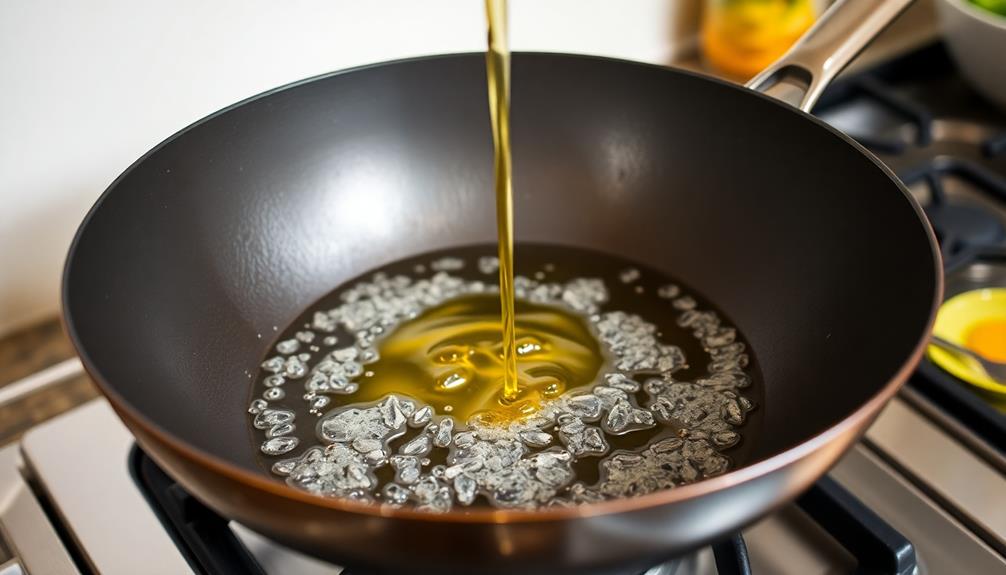
Heating the oil is the first crucial step in the Khao Pad cooking process.
You'll want to use a large wok or skillet and pour in about 2-3 tablespoons of vegetable oil. Turn the heat to medium-high and let the oil heat up until it shimmers and becomes fragrant, which should take around 30 seconds to a minute.
Be careful not to let the oil smoke or burn – that's a sign it's too hot. Once the oil is ready, it's time to add your ingredients and start stir-frying.
The hot oil will help sear and flavor the food, locking in those delicious Thai aromas. As you cook, keep the ingredients moving constantly by stirring and tossing them in the pan.
This ensures even cooking and prevents anything from burning. Stay vigilant and adjust the heat as needed to maintain the perfect sizzle.
Heating the oil properly is key to achieving that perfect Khao Pad texture and taste.
Step 2. Add the Eggs
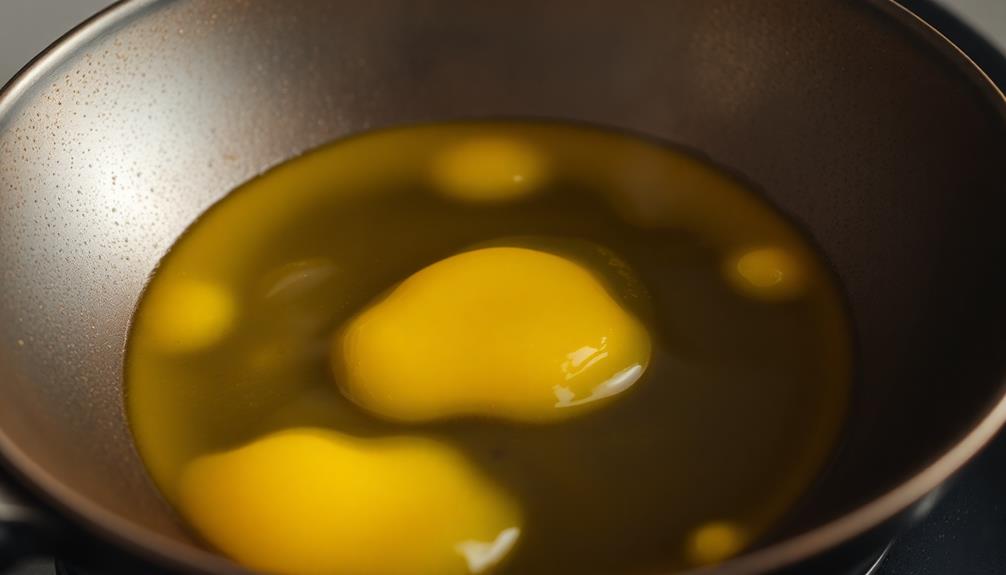
Once the oil is hot and shimmering, crack 2-3 eggs directly into the wok or skillet. The eggs will immediately start to sizzle and cook. Use your spatula to gently push and fold the eggs, making sure they don't stick to the pan. You'll want to scramble the eggs, breaking them up into small pieces as they cook. This should only take about 1-2 minutes.
Once the eggs are mostly cooked through, push them to one side of the pan. This will create some open space for the remaining ingredients.
Add the cooked rice, soy sauce, fish sauce, and any other seasonings you're using, like garlic, onions, or chili peppers. Stir everything together, incorporating the eggs throughout the rice.
Continue cooking and stirring for 2-3 minutes until the rice is heated through and all the flavors have melded together. Taste and adjust seasonings as needed. Your delicious Thai fried rice is now ready to serve!
Step 3. Add the Aromatics

With the eggs now cooked, it's time to add the aromatic ingredients. Grab your spatula and push the eggs to the side of the wok, creating an open space in the center.
Into this hot spot, add a splash of oil and let it heat up for a few seconds. Toss in the sliced onions, minced garlic, and julienned ginger. Sauté these aromatics, stirring frequently, until they become fragrant and the onions start to soften, about 1-2 minutes.
The key is to let the aromatics "bloom" in the hot oil, releasing their essential oils and flavors. Be careful not to burn the garlic – keep it moving!
Once the onions are translucent, push the aromatic mixture to the side again. Now add the cooked rice to the center of the wok. Use your spatula to break up any clumps and mix the rice with the aromatic ingredients.
Stir and toss the rice continuously, ensuring even cooking and coating everything with the flavorful oil.
Step 4. Add the Protein

With the aromatics sizzling and infusing the rice, it's time to add the protein.
You'll want to choose a protein that complements the other flavors in the dish, such as chicken, shrimp, or tofu. Gently lower the protein into the pan, being careful not to overcrowd the surface.
Allow the protein to sear and develop a nice golden-brown crust before stirring it into the rice. This will ensure the protein is cooked through and adds a delightful textural contrast to the dish.
As the protein cooks, it'll release its own unique flavors, blending seamlessly with the aromatic base you've already established.
Keep a close eye on the pan, stirring occasionally, until the protein is cooked to your desired doneness.
With the protein now integrated, the fried rice is really starting to come together, building layer upon layer of mouthwatering flavor.
Step 5. Add the Rice
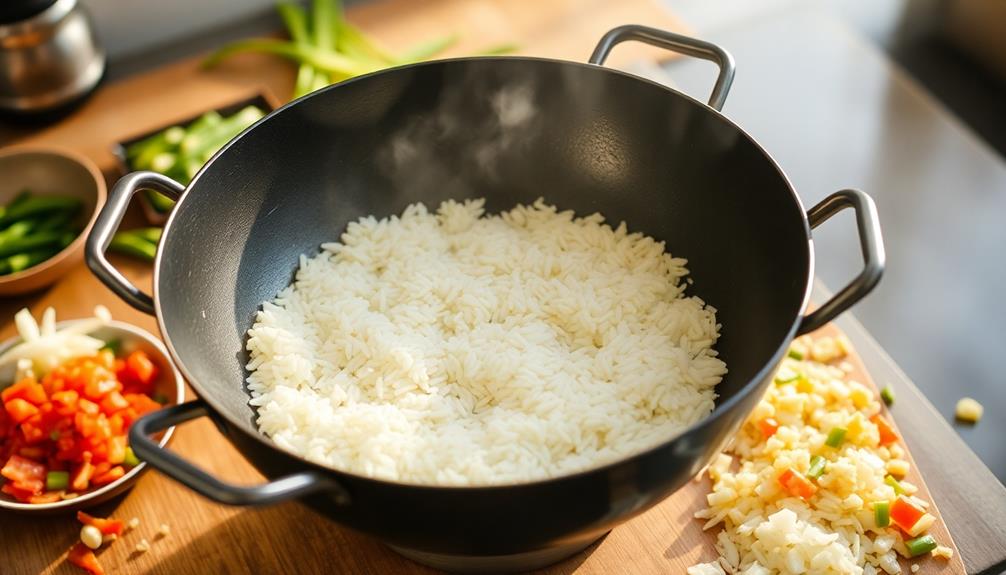
Add a cup of the fragrant, long-grain rice to the wok or skillet. Stir the rice around to coat it evenly with the oil and other ingredients already in the pan.
You'll want to let the rice sizzle and brown a bit, which helps develop its nutty flavor. After a minute or two, pour in about a quarter cup of hot chicken or vegetable broth. This will help steam and soften the rice, making it fluffy and tender.
Gently fold the rice, letting it absorb the flavorful broth. If the rice seems to be drying out, add a splash more broth. Cook for 3-4 minutes, until the rice is heated through and has a pleasant chew.
Taste and adjust any seasonings as needed. The rice is now ready to be combined with the cooked vegetables, protein, and other tasty ingredients to create your delicious Thai fried rice masterpiece.
Final Thoughts
Savoring the final bites of the aromatic Khao Pad, you're left with a deep appreciation for the dish's harmonious blend of flavors and textures. The perfect balance of salty, sweet, and savory notes lingers on your palate, leaving you craving more.
What makes this Thai fried rice so captivating is the way each ingredient seamlessly complements the others, creating a symphony of taste and aroma.
As you reflect on the meal, you can't help but feel a sense of accomplishment for mastering this classic Thai dish in your own kitchen. The ability to recreate the rich, umami-packed flavors of a restaurant-quality Khao Pad is a testament to your culinary skills.
Moving forward, you'll find yourself eager to experiment with different protein options, vegetables, and spices to put your own personal spin on this versatile dish.
Khao Pad has undoubtedly earned a permanent place in your culinary repertoire, becoming a go-to meal that satisfies both your taste buds and your desire for a delicious, homemade experience.
Frequently Asked Questions
What Rice Is Best for Making Thai Fried Rice?
When making Thai fried rice, you'll want to use a long-grain rice like jasmine rice. It has the perfect texture and flavor to stand up to the bold seasonings and quick cooking method used in this dish.
Can I Use Leftover Rice to Make Khao Pad?
You can absolutely use leftover rice to make fried rice. In fact, day-old rice works best, as it's drier and less sticky, making it perfect for stir-frying.
How Do I Get the Perfect Texture for Khao Pad?
To get the perfect texture, you'll want to use day-old, chilled rice. Toss the rice in a hot wok with a bit of oil, letting it crisp up before adding other ingredients. The texture should be light, separate, and slightly chewy.
Is Khao Pad Gluten-Free?
Yes, khao pad is typically gluten-free as it's made with rice, vegetables, and protein, without any wheat-based ingredients. As long as you use gluten-free soy sauce or tamari, you can enjoy this Thai dish without worrying about gluten.
Can I Make Khao Pad Vegetarian or Vegan?
You can certainly make khao pad vegetarian or vegan. Simply swap out the protein for tofu, tempeh, or your preferred plant-based substitute. Adjust seasonings as needed to accommodate the change in ingredients.


